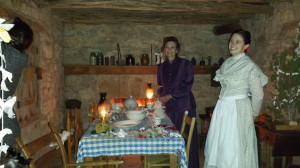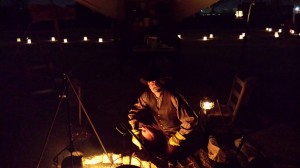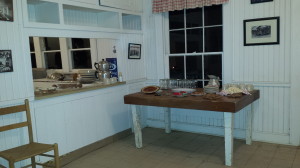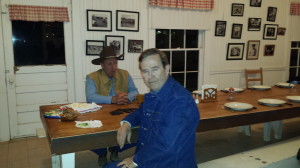For one weekend each December, the National Ranching Heritage Center in Lubbock hosts a Christmas event, Candlelight at the Ranch. The Center is a museum and historical park affiliated with Texas Tech University. Sitting on 27.5 acres, the facility contains 48 structures that have been relocated from across the state. Candlelight at the Ranch is a walking tour through some of the buildings where reenactors show what Christmas was like on the plains throughout the years. What follows below are some of the photos I took at this year’s event. The camera on my phone didn’t always pick up things well, so for some I’ve got with and without flash versions. I don’t know the names of the people in the photos, but I would like to thank them for doing this and for putting up with the flash on my camera.
The first photo shows two ladies preparing for Christmas in 1872 at the Jowell House. The house is from Palo Pinto County. The walls were thick to protect from attacks by Commanches.
On the plains, there isn’t much shelter from the wind, which blows pretty much all the time. In the winter the wind chill can be quite harsh. Many cowboys made what is called a half-dugout to provide some shelter when they were out on the range. The structure was small and wasn’t entirely below ground, being built on the side of a small rise. Here a cowboy plays Christmas carols on his guitar, circa 1888. Last year, the line was short enough that we were able to stand there a minute and sing along with him. This year there were too many people. This half-dugout is from Dickens County.
Of course, if the cowboys were lucky, they could spend Christmas in the bunkhouse. The picture below shows the Bunkhouse from the JY Ranch in King County in 1879. The cowboy in the photo was occupying himself with a common activity in the evenings, repairing a piece of tack. Visitors stood in the door and looked into most of the buildings. It was a cool night, but not too cold. Still the heat from that fire felt good, even over by the door.
Visitors stood in the door and looked into most of the buildings. It was a cool night, but not too cold. Still the heat from that fire felt good, even over by the door.
Electricity didn’t come to the plains until the 1900s. In the next few photos, all of the activity was done by lantern light. I’ve included one photo without flash to show how the lighting really looked.
In the first picture, the women are singing Christmas carols. The second and third photos show a couple of girls helping make Christmas cookies. All three images are of the Harrell House, from Scurry County, 1900. 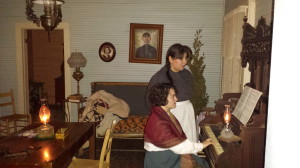
Several things struck me about this particular exhibit, if that’s the right word. First, the women singing were the first thing you saw. The house was long, with a breeze way separating one of the bedrooms from the rest of the house. There were no Christmas TV specials, CDs with the latest Christmas albums by popular artists, or chuurch choir Christmas pageants. If you wanted to hear Christmas music, you probably had to play it yourself.
 The second thing was that cooking was much more time consuming and labor intensive, since everything had to be made from scratch and then cooked on a wood burning stove. Still, as the girls in the pictures demonstrated, when the whole family pitched in, it could be a lot of fun. They seemed to be having a good time. They weren’t the only one cooking at this house.
The second thing was that cooking was much more time consuming and labor intensive, since everything had to be made from scratch and then cooked on a wood burning stove. Still, as the girls in the pictures demonstrated, when the whole family pitched in, it could be a lot of fun. They seemed to be having a good time. They weren’t the only one cooking at this house.
The chuck wagon was an important part of frontier life, especially for cowboys. The man in the photo was brewing coffee over the fire and cooking biscuits in the dutch oven. I was hoping he would offer me one since there are few things better than biscuits hot out of a dutch oven. Sadly, no such luck.
The wealthy in the early 1900s had an easier life. For one thing, they had electricity sooner. The two photos below are from the Barton House, Hale County, 1909. In the first, the ladies quilt while children decorate the Christmas tree behind them. In the dining room “Mr. Barton” and his grandson construct a gingerbread house. (They weren’t sharing, either.)
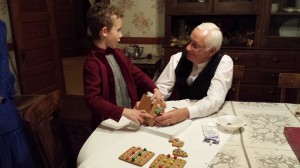 This is one of the most modern structures on the property that is used on the tour. None of my pictures of the exterior came out clear, but it’s a large two-story house. I would have liked to have stayed and observed longer but this part of the tour is always crowded. Plus my family were getting cold and wanting some hot chocolate.
This is one of the most modern structures on the property that is used on the tour. None of my pictures of the exterior came out clear, but it’s a large two-story house. I would have liked to have stayed and observed longer but this part of the tour is always crowded. Plus my family were getting cold and wanting some hot chocolate.
By the 1950s, life on the ranch had become less primitive. On the Pitchfork Ranch in Dickens County the cookhouse was a popular place at all times of the year, but especially at Christmas, where the cowboys would gather to eat and play cards.
This is the most modern building on the tour. It almost looks like something out of a movie. There’s a second long table in the foreground that isn’t in the picture.
 Of course, no collections of Christmas photos from the South Plains would be complete without an oil rig decked out as a Christmas tree.
Of course, no collections of Christmas photos from the South Plains would be complete without an oil rig decked out as a Christmas tree.
Candlelight at the Ranch is usually the first or second weekend of December. If you want to attend next year, check their website for dates and times. The National Ranching Heritage Center is open year round and host a number of events throughout the year. It’s also open to visitors to come and stroll the grounds or see one of several exhibits on display.
Hours of operation:
Monday – Saturday, 10 a.m. to 5 p.m. Sunday, 1 to 5 p.m. Outdoor park closes at 4 p.m. daily Closed on all TTU Holidays There is no admission charge, and the facility is accessible to persons with special needs. The National Ranching Heritage Center is located east of Indiana on Fourth Street, in Lubbock, Texas. Mailing address is P.O. Box 43200, Lubbock, TX 79409-3200.

